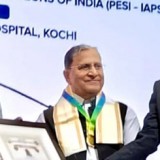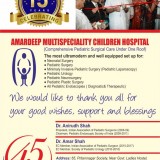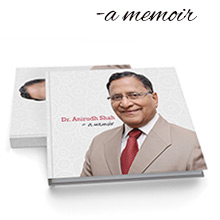INFORMATION AVAILABLE IN ENGLISH, GUJARATI AND HINDI
What is laparoscopic or keyhole surgery?
Keyhole surgery, or laparoscopic surgery as it is also known, is a method of carrying out an operation without having to make a large incision. Many different types of operations can now be carried out using keyhole surgery. This type of surgery reduces the length of time your child needs to stay in hospital and leaves little scarring.
What are the advantages of keyhole surgery?
Children tend to recover more quickly after keyhole surgery and have fewer side effects. There is little scarring after keyhole surgery which becomes more important as your child grows older and becomes more self-conscious. One side effect of ‘open’ surgery – minimised with keyhole surgery – is ‘adhesions’. This is where internal organs stick together and form bands of scar tissue, which can be painful and cause obstruction. Adhesions have been proven to occur less often in adults after keyhole surgery, and the risk of adhesions in children after keyhole surgery is thought to be less as well.
Are there any risks?
Every anaesthetic carries a risk of complications but this is very small. Your child’s anaesthetist is an experienced doctor who is trained to deal with any complications. After an anaesthetic, children sometimes feel sick and vomit, may have a headache, sore throat or feel dizzy. These effects are short-lived. Any surgery carries a small risk of infection or bleeding.
After the operation, some older children may complain of shoulder pain. Your child may also feel some crackling under the skin because the carbon dioxide sometimes escapes into the tissue just under the skin. These side effects are usually short-lived and do not require any specialized care.
There is always a chance that keyhole surgery will not be possible for your child. Sometimes the surgeon will not be able to carry out an operation using the keyhole method for technical reasons or because of unexpected findings. If this is the case, the surgeon will carry out the operation using a larger incision instead.
Are there any alternatives to keyhole surgery?
All operations carried out as keyhole surgery can also be carried out using ‘open’ surgery, that is, with a larger incision.
What does the operation involve?
Your child will be given a general anaesthetic and will be asleep during the operation. Once your child is asleep, the surgeon inserts a small tube called a cannula into your child’s tummy button. A telescope, with a miniature video camera mounted on it, is inserted into this tube to project a very high quality video image onto a television screen. The abdomen is then inflated with carbon dioxide to create space in which the surgeon can operate. The operation is performed by inserting specialized instruments which are passed through small hollow tubes which are inserted through separate very small incisions. There may be two or more small incisions required to perform the operation. Once the operation is over, the surgeon will stitch up the inside of the holes and your child will be taken to the recovery room to wake up from the anaesthetic.
What happens after the operation?
After the operation, your child will return to recover.
Your child may also have a naso-gastric tube, which is a tube passed through the nose into the stomach, so that he or she can be given feeds or medicines easily. Your child may also have an intravenous (into a vein) infusion of fluids as he or she may not feel like eating and drinking after the operation.
You may be able to feel a few lumps under the skin by the wound sites, which are stitches inside the body. This is nothing to worry about and the stitches will dissolve on their own in about three months.
GUJARATI
દૂરબીન વડે પેટનાં ઓપરેશન (લેપ્રોસ્કોપી અને થોરેકોસ્કોપી)
લેપ્રોસ્કોપી:
“લેપ્રોસ્કોપી” એટલે પેટ પર નાના છિદ્રો દ્વારા દૂરબીન અને સાધનો મુકી પેટનાં વિવિધ આૅપરેશન કરવા. બાળકોમાં અને નવજાત શિશુઓમાં આ ટેકનિકથી ફ્ક્ત ૩ મીમી અથવા ૫ મી.મી.નાં નાના કાણાથી આૅપરેશન કરવામાં આવે છે. આધુનિક કેમેરા અને લાઈટની મદદથી ટી.વીમાં મોટી ઈમેજ જાઇ આવા આૅપરેશન ખૂબ જ સારી અને ચોક્કસાઇ પૂર્વક થાય છે.
લેપ્રોસ્કોપીની ટેકનિક શીખવા માટે બાળકોનાં સર્જનએ ચોક્કસ પ્રકારની ટ્રેનિંગ લેવી પડે છે અને તેના માટે સ્પેશ્યલ સાધનોની જરૂર પડે છે.
નવજાત બાળકો અને મોટા બાળકોમાં લેપ્રોસ્કોપીના મુખ્ય આૅપરેશન આ પ્રમાણે છેઃ
– એપેન્ડીક્સ
– ઇન્દ્રની ગોળી પેટમાં હોય (અનડીસેન્ડેડ ટેસ્ટીસ)
– પેટમાં ગાંઠ હોવી.
– અંડાશય(ઓવરી)માં ગાંઠ
– લીવરની ગાંઠ
– મેકલ્સ ડાયવરટીક્યુલમ
– કિડની નળીનાં આૅપરેશન
– ઉદરપટલનાં હર્નીયા
– સારણ ગાંઠ
આ સિવાય બીજા અનેક આૅપરેશન લેપ્રોસ્કોપી દ્વારા બાળકોમાં થાય છે. લેપ્રોસ્કોપીના આૅપરેશનથી બાળકને દુઃખાવો ખૂબ જ ઓછો થાય છે. લોહીની જરૂર નથી પડતી અને પેટ પર ગંદા કાપા નથી પડતાં. બાળક નું હાÂસ્પટલમાં થતું રોકાણ પણ ઓછું થઈ જાય છે.
આધુનિક મેડિકલ સાયન્સ અને ટેžનોલોજીની આ એક અદ્ભૂત શોધ છે. •
થોરેકોસ્કોપી:
થોરેકોસ્કોપી નાના છિદ્રો દ્વારા છાતીનાં રોગો માટે દૂરબીનથી આૅપરેશન કરવાની ટેકનિક છે. ‘લેપ્રોસ્કોપી’ પેટનાં આૅપરેશન માટે છે. ‘થોરેકોસ્કોપી’ છાતીના આૅપરેશન માટે છે.
છાતીનાં આૅપરેશન પહેલાં ખૂબ મોટા કાપા પાડી કરવામાં આવતાં હતાં. પણ આધુનિક ટેકનોલોજી અને સર્જનની કુશળતા થી હવે ૩ મીમી અથવા ૫ મીમી નાં નાના નાના છિદ્ર દ્વારા જટિલ છાતીનાં આૅપરેશન કરવામાં આવે છે.
થોરેકોસ્કોપી દ્વારા થતાં મુખ્ય આૅપરેશનો :
૧) બાળકની છાતીમાં પરૂ થવું (ઍમ્પાઈમા)
૨) ફેફસાંનો અમુક ભાગ ખરાબ હોય તો તે કાઢવાના આૅપરેશન
૩) ફેફસાંમાં સીસ્ટ હોય (દા.ત. હાયડેટીડ સીસ્ટ )
૪) અન્નનળીની ગાંઠો (ડુપ્લિકેશન સીસ્ટ)
૫) છાતીમાં ટી.બી. અથવા કેન્સરની ગાંઠ.
૬) નવજાત બાળકમાં શ્વાસનળી અને અન્નનળી જાઇન્ટ હોય.
૭) થાયમસ ગ્રંથિની ગાંઠનું આૅપરેશન.
આમ, અનેક પ્રકારનાં બાળકોના છાતીનાં રોગોનું આૅપરેશન થોરેકોસ્કોપી દ્વારા સર્જન સહેલાઈથી કરી શકે. આૅપરેશન બાદ દુઃખાવો પણ ખૂબ ઓછો થાય છે અને બાળકને હાÂસ્પટલમાંથી પણ વહેલી રજા મળી શકે છે.
આ આૅપરેશન ઓપન આૅપરેશનથી વધુ ખર્ચાવાળા નથી હોતાં. •
HINDI
दूरबीन से पेट की सर्जरी (लेप्रोस्कोपी और थोरेकोस्कोपी )
लेप्रोस्कोपी:
‘लेप्रोस्कोपी’ सर्जरी की एक पद्धति है, जिसमें कोई बड़ा चीरा किये बिना पेट में छोटे छेद करके दूरबीन और अन्य उपकरणों द्वारा पेट के विभिन्न प्रकार के ऑपरेशन किये जाते हैं। इस तकनीक में नवजात शिशु और बड़े बच्चों के ऑपरेशन मात्र ३ और ५ मिलीमीटर के छेद करके किया जाता है।
इस प्रक्रिया में बच्चें को बेहोश करने के बाद बाल सर्जन बच्चे के पेट में छेद करके एक छोटी ट्यूब डालते हैं, जिसपर एक आधुनिक कैमरा और लाइट लगी हुई होती है, जिसकी मदद से टी.वी में बड़ी इमेज दिखाई देती है और बड़ी ही सावधानीपर्वूक ऑपरेशन किया जाता है। इस सर्जरी में दो या अधिक छोटे छेद करके ऑपरेशन किया जाता है। इस तकनीक के लिए बाल सर्जन को विशेष प्रकार की ट्रेनिंग लेनी पड़ती है और इसमें विशेष उपकरणों का इस्तेमाल करने की आवश्यकता है।
नवजात बच्चों और बड़े बच्चों में लेप्रोस्कोपी ऑपरेशन मुख्य रूप से नीचे दिये गये रोगों के लिए किया जाता हैः
१. ऐपेन्डिक्स
२. अनडीसेन्डेड टेस्टीस
३. पेट के अंदर गांठ होने के कारण
४. अंडाशय में गांठ, लीवर में गांठ
५. मेकल्स डायवरटीक्युलम
थोरेकोस्कोपी:
यह सर्जरी छाती के विभिन्न रोगों के लिए छोटे छिद्र करके दूरबीन से ऑपरेशन करने की तकनीक है। इसे सामान्य तौर पर थोरेकोस्कोपी कहा जाता है।
छाती के रोगों के लिए पहले के समय में बहुत बड़ा चीरा करके ऑपरेशन किया जाता था। लेकिन आधुनिकी उन्नत तकनीकों और सर्जन की विशेषज्ञाता से अब ३ मिलीमीटरऔर ५ मिलीमीटर के छोटे छेद करके इतने ही आकार के उपकरणों से छाती के जटिल ऑपरेशन किये जाते हैं।
मुख्य रूप से यह ऑपरेशन बच्चों में नीचे दिये गये रोगों के लिए किया जाता हैः
१) बच्चे की छाती में मवाद (एंपियेमा)
२) फेफडों के किसी खराब हिस्से को ऑपरेशन से निकालना
३) फेफडों में सिस्ट (जैसे की श्वसनीजन्य पुटी [Bronchogenic Cyst] और जलस्फोट पुटी [ Hydatid Cyst])
४) आहारनली की गांठे (डुप्लीकेशन सीस्ट)
५) छाती में टी.बी. या कैंसर की गांठ
६) नवजात शिशु की श्वासनली और अन्ननली जॉइन्ट होने पर
७) थाइमस ग्रंथि की गांठ
इस प्रकार बच्चों की छाती के रोगों के कई ऑपरेशन थोरेकोस्कोपी द्वारा सर्जन बहुत ही कुशलता से करते हैं। इस ऑपरेशन से बच्चे को बहुत कम दर्द होता है और अस्पताल से जल्दी छुट्टी मिल जाती है। ये ऑपरेशन ओपन ऑपरेशन से अधिक खर्चीले नहीं होते। •




